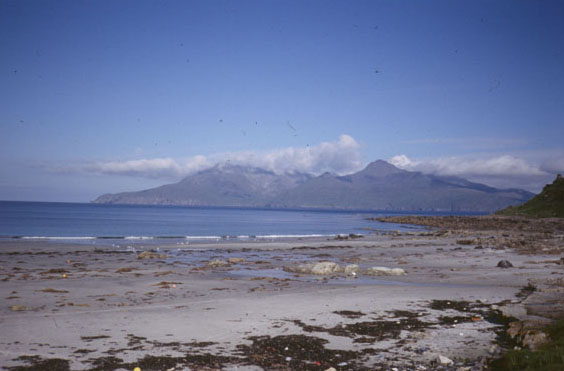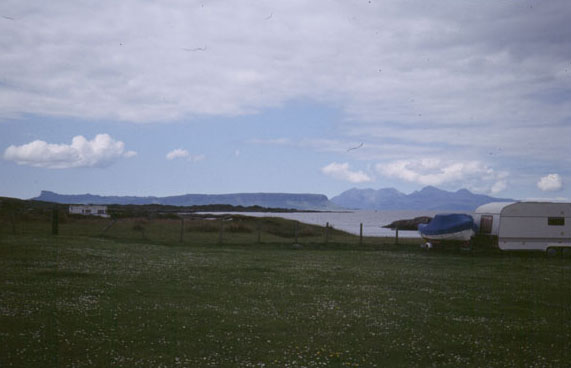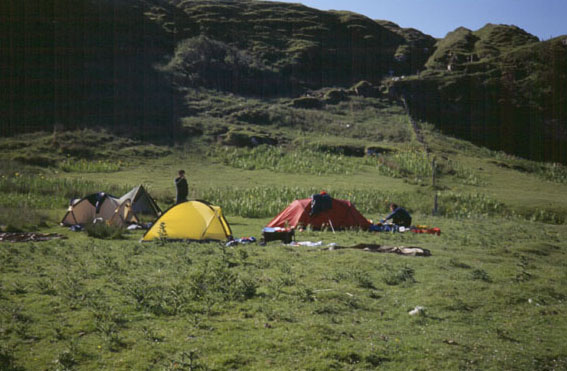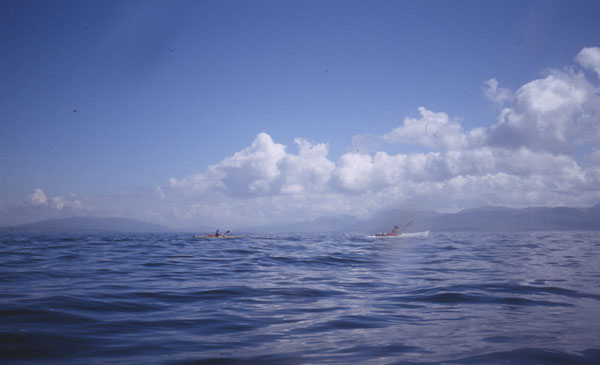Arisaig - the first time
|
The story of my first sea kayaking
trip. (Circa 1988). |
Owen Merrick |

Rum, as seen from Camas Sgiotaig on Eigg
Noise outside the tent announced it was morning, I tried ignoring it
for a few minutes more, but there was no getting away from the fact,
it was time to get up. I wouldn’t have minded so much but I’d only crawled
into my doss bag two hours earlier after driving up overnight from England.
“Hay–up-me-duck” said Phil as I straightened up.
“Who’s been sandpapering my eye balls” I snapped.
“Oh full of the joys of spring; then.”
“Hummm” I look around and then
“WOW!!! WHERE DID THAT COME FROM??”
I was looking out at a Caribbean island. The cliffs looked like a row
of paving slabs end on, at the far end a huge rhino horn stuck up into
the sky; and what a sky? This wasn’t a Scottish sky, this was a sky
stolen from a cowboy movie, a big wide blue sky from the Great Plains;
what was it doing here in gray Scotland? On my left the sea just seemed
to go on forever, in front “THE ISLAND” and behind it another more massive
island of charcoal gray mountains all jaggy peaks and ridges. Further
right the big solid lump of the Cuillins, much nearer, a thin finger
of land stuck out into the sea. A finger of land we were to become much
better acquainted with later in this trip.

The rest of our would-be little gang came over tea in hand; both were
university lecturers from Bath. There was Brian a one time pioneer of
cave diving (the fact he was still alive greatly impressed me) and Steve
who was mainly into white water.
Phil and Brian had met in Pembroke whilst doing some course called “Sea
Proficiency” I didn’t know what this was but it sounded like they should
know what they were doing.
After brief introductions Brian turned to me and said.
“We’re thinking of going out to that island out there, are you up to
that?”
“Oh aye” I said smiling and trying to sound confident, after all I’d
had whole a day and a half paddling around Anglesey. Surely that made
me an old hand at this sea kayaking lark. “Should be cracking”.
“Yer, he’ll be all right” added Phil. And with that rounding recommendation
we set about getting ready.
An hour later we were breakfasted, packed and ready; at least three
of us were. Phil was still at it, re-packing his boat for the fifth
time. It seems that every item had to go into is own labeled nylon bag
these then had to be put into the correct dry bag according to the list
on the outside. Each dry bag then had its own place in his kayak; trouble
was that they didn’t all fit where they were meant to go. I think that
Phil had devised this packing plan at home and forgotten to leave space
for incidental things like food and water. After the sixth re-pack he’d
had enough of the increasingly sarcastic abuse being hurled in his general
direction and declared he was ready.
At last we were off, weaving our way through some small rocky islets
and out into open sea, heading for the right hand side of the island;
the Isle of Eigg.
To begin with we stuck together, paddling along chatting away but after
a while conversation dried up and we drifted off into our own thoughts.
I noticed that my kayak was definitely listing to the right; I must
have put something heavy on that side but couldn’t think what. I shifted
my weight left as best I could and tried to ignore it. Next I became
aware that it was getting hot, ten o’clock and it was already into the
high 60’s; it was going to be a scorcher. I was wearing, as we all were,
blue heli-hanson fibre pile shirt and pants under salopettes and cag
made of neoprene coated nylon. At the time this was “de rigueur” paddling
attire, the only other alterative was a thick stiff wetsuit that rubbed
the skin off your arm pits as you paddled. There were breathable fabrics
around but the considered wisdom at the time was that salt would block
up the pores and ruin the garment; so we paddled on and slowly cooked.
About half way across we stopped as a fishing boat crossed in front
of us its net out and a flock of seagulls and a pod of dolphins in hot
pursuit.
“Wow look dolphins” I shouted.
“Oh yes” was all the reaction I get from the others. Obviously, they’ve
see so many dolphins whilst out paddling they’ve become blasé
about them.
After four hours of paddling we rounded the north end of Eigg and into
Camus Sgiotaig.
“So that was an open crossing; what’s all the fuss about?” I thought.
(Looking back words like ignorance and bliss come to mind).

We needed somewhere to stop urgently. A white sand beach came into
view; that’ll do nicely. The feeling of sunshine on our soggy skin as
we ripped off now saturated fibre pile was sheer bliss, followed by
shock as we realised that there were other people around. Then a mad
scramble to find at least a pair of shorts to put on. It was a bit early
to stop but as this was such a good campsite we decided to stay. We
spent the afternoon sunbathing and re-hydrating.

There was even less cloud in the sky the next day, the sea was ripple-less
with a shiny glass finish. We passed on the boil-in-the-bag experience
of the day before shorts, lifa top and bare feet was more than enough.
Before we could get away Phil gave us one more performance of his kayak
packing routine; deep joy.
The Isle of Rum was once the private fiefdom of some Lord Knob, this
private fiefdom then passed into the hands of the Nature Conservancy
Council. You weren’t supposed to turn up without prior arrangement,
which we naturally hadn’t made; we paddled over anyway(1). In the mouth
of Loch Scresort we stopped for our first Chinese Parliament. Do we
go into Kinloch and risk an uncertain reception from the camp commandant
or paddle by and ignore the place. Brian it transpired wasn’t into visiting
places he wanted wilderness and nothing else. He’d done quite a lot
of paddling in British Columbia and Alaska and wanted to recreate that
“far from the madding crowd” feel on his kayaking trips. The other two
weren’t bothered either way so we paddled on leaving the delights of
Kinloch for another day. A couple of miles past the loch we hauled out
onto some rocks for a brew and another Chinese Parliament. The trouble
was we really didn’t have a clue where we were going next. We’d been
in such a rush to get out to the islands that we’d not really thought
beyond that. We had two days left, after consulting the maps it was
clear we didn’t have enough time to circumnavigate Rum and get back.
We could have gone to Canna but instead we decided on Soay and Loch
Scavaig.
Seven miles to Soay, a mere two hours paddling, hardly worth calling
an open crossing. We couldn’t see Soay against the backdrop of Skye
so just headed in the general direction of Gars-bheinn; the southern
end of the Cuillin ridge. Once across no one wanted to explore the island
with me; so we headed off into Loch Scavaig.
I’d climbed on the Cuillins, I’d done “the ridge” and I’d looked down
on this loch from on high; I was really looking forward to seeing this
loch. As I paddled in I was aware of the high pitched whine of an outboard
engine but thought nothing of it. The deeper into the loch I went the
loader the noise got. At the back of Loch Scavaig behind Eilean Reamhar
is Loch na Cailce there were two yachts anchored here. Going around
the yachts was an idiot in a dingy, just going round and round. The
noise was rebounding off the cliffs and shattering the atmosphere of
the place. Disgruntled, I turned and paddled off in the direction of
Camasunary.
It’s often said that a British summer is two sunny days and a thunder
storm; and that’s just what we got. The evening grew hot and humid with
dark clouds gathering on the hills. By morning it was poring down and
an east wind was beginning to stir. Safe under the shelter of the Strathaid
peninsular we paddled south past Elgol. Our world shrank to the small
circle around us that we could see. At the end of the peninsular we
poked our noses out from behind the small islet of Eilean na h-Airde
and SPLASH! Short choppy waves were hitting us straight in the face.
Whole squadrons of white horses were coming at us on full charge. Hidden
under the cliffs we hadn’t realised just how much the wind had risen.
Four miles away, directly up wind, we could just make out Tarskavaig
Bay; four miles of churning, dancing freezing cold waves. My friends
became just coloured blurs out to the sides; my focus was on the next
wave, then the one after. Punching my bow through each wall of water
became everything. You just had to ignore the force of the waves hitting
you and the cold water slapping you in the face and running down the
neck of your cag. I remember think that “maybe there was more to this
kayaking game than I thought”.
Slowly almost imperceptibly we moved across that loch and into the shelter
of Tarskavaig Bay. We huddled together in a cave whilst brewing up some
tea. One thing we all agreed on was that fibre pile was useless insulation
once wet. It was the middle of June and here we were frozen to the core.
What to do next? Going on wasn’t very appealing but neither was lying
in a wet tent all afternoon; besides we weren’t sure the tents would
hold up to this wind. We pushed on hugging the base of the cliffs looking
for somewhere better to camp. Next thing we knew it was getting dark,
lightning was flashing all around the wind was howling and we were at
the Point of Sleat.
In front of me blocking my view around the point was a huge ridge of
water. A wave that didn’t move, this was weird, I’d never seen this
before.
“Phil what do I do here”.
“Just keep paddling, what ever you do don’t stop paddlin”.
So I paddled forward and up over the wave. Suddenly my bow was out the
other side of the wave, supported by nothing but air. It swung down
and landed with an all mighty slap and splash in the trough.
“Keep paddling” screamed Phil above the wail of the wind.
I paddled up the next wave and again the bow came crashing down. Then
the third wave, it seemed higher and steeper somehow; up I went and
down came the bow only this time there was no splash. I wasn’t in the
next trough I was above it and my kayak was almost vertical. Gravity
came into play at this point. Down I went and the water was up to the
hatch. Still the bow went down and the water was up to the cockpit.
Then up to my waist.
“Ooo Err” I thought.
By now I was standing on the footrests, my back flat on the deck. As
the water came up to chest height, buoyancy finally restored equilibrium.
Somehow when the bow came up I was still upright.
“Keep paddling” I told myself.
And then the waves were back to normal, short choppy ones; almost friendly.
Somewhere, just short of Aird of Sleat, we found a small bay with some
seaweed covered rocks to land on. Some cattle were running around, excited
by the thunder; they took flight as we appeared. There was just enough
grass for one tent by this time it was dark we couldn’t be bothered
to look for anywhere else. The four of us squeezed into one tent like
sardines. Next thing I knew it was light, the rain had stopped and the
wind had died. Lulled into a false sense of security I crawled out only
to be set upon by vicious thugs with malicious intent. We didn’t stop
for anything, not for breakfast, not for Phil’s packing antics, we were
on the water in less that ten minutes; anything to escape the deadly
midges.
Once on the water we could take in our surroundings, the sea was calm
the sun was out it was as if the storm of the day before never happened.
BA’s, cags and shirts came off as we set off on our last crossing back
to Arisaig.

“Yes” I thought “I could get into this”.
(1) You no longer need to make prior arrangements to visit Rum.
Owen Merrick - 2008
|



